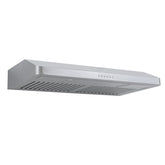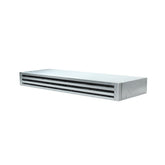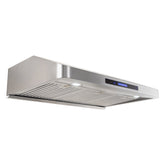You just bought your carbon steel wok and you’re anxious to get cooking. But don’t throw it on the burner quite yet (and be careful, you wouldn’t want to dent your new wok.)
It needs to be seasoned before you can start stir-frying or cooking with it. This is an easy process that you’ll only have to do a few times, ever. Don't forget to turn on your kitchen hood vent when seasoning your wok to help clean the air.
Seasoning your wok creates a non-stick surface that lasts for years to come. It also adds flavor to your food. Every time you cook the layer of seasoning gets tougher. As long as you avoid acidic foods, it should last for years.
Compared to stainless steel, carbon steel is more prone to rust and corrosion. Seasoning your carbon steel wok builds up a nice protective coating to protect the pan from rust.
Carbon steel is popular because it is so lightweight and conducts heat quickly. Also, it’s completely non-toxic and safe to use. Like other types of woks, you can reseason it if the layer of oil wears off.
Carbon steel woks are great to use on electric stoves as long as they have a flat bottom. But, because they are lightweight, they will move around on glass stoves. This can scratch your stovetop.
Now that you’ve learned a little about carbon steel woks, we want you to start cooking delicious stir-fry as soon as possible.
We’ll show you how to season a carbon steel wok in just eight steps.
What You Need
- Any oil with a high smoke point (peanut oil, canola oil, etc.)
- Dish soap
- Water
- Sponge or scrub brush
- Paper towel or microfiber towel
- Barbecuer’s brush
1. Clean your carbon steel wok off with dish soap and hot water.
This is the only time you’ll use soap and abrasive scrubbers to clean your carbon steel wok. The goal of seasoning is to get a thin coat of oil on the bottom of your wok that essentially cooks onto the pan over time.
Tip: After this initial clean, avoid cleaning your wok with dish soap. It will eat away at this coating and you’ll have to season it again.
2. Dry your wok with a microfiber towel or paper towel.
Before you add oil and start to heat your wok, make sure it’s completely dry.
3. Coat the interior of the carbon steel wok with 2 tablespoons of oil.
Oil is the main ingredient for seasoning your wok. Since it can get quite hot, peanut oil, canola oil, or other types with a high smoke point are best. You can use a barbecuer’s brush to spread the oil evenly.
4. Turn your stove on high and let the wok heat up for about 10 minutes.
If your oil smokes a little, that’s OK. Heavy smoke means the wok is too hot. If a little water evaporates on the wok, it’s just right. Just wet your hand and flick some water in the wok to test this out.
As your wok heats up, it may turn brown, black, or blue due to the heat. This is normal.
5. Let the wok cool for five to 10 minutes.
Rather than drying the carbon steel wok with a towel, just let it dry naturally. You don’t want to ruin the oil coating.
6. Rinse the carbon steel wok with hot water.
When you rinse, make sure to avoid soap and all other cleaners, abrasive or not. Again you want to preserve the oil coating as best as possible.
7. Heat it until all the water evaporates.
Heating your wok helps solidify the oil onto its surface.
8. Let the carbon steel wok cool.
That’s it; you’re done! As you use your carbon steel wok, it will turn a copper brown color, and eventually after a year or more of use, black. These color changes are supposed to happen. So don’t worry if your wok doesn’t look like the shiny pan you bought several months ago.
If your food still sticks a little, don’t worry. The non-stick surface will develop over time.
Keep in mind that carbon steel woks do not come with non-stick coatings like polytetrafluoroethylene (PTFE) or Teflon. Once you remove the factory coating you’re dealing with pure carbon steel.
This means you should always season your carbon steel wok. The layer of oil lasts much longer so it doesn’t need a lot of maintenance.
There are many different ways you can season your carbon steel wok. Check out a complete list right here.
Frequently Asked Questions
How do you perfectly season a carbon steel pan?
The key is to preheat the wok long enough that the oil starts to harden or polymerize. Make sure to spread the oil along the interior of your wok using a paintbrush or a paper towel. You can hold the paper towel against the pan using any cooking utensil. Use no more than two tablespoons of oil. Otherwise, your wok may get sticky.
What is the best oil to season a carbon steel pan?
The best oil to season a carbon steel pan is peanut oil, canola oil, or avocado oil. Any oil with a high smoke point works. Just stay away from olive oil as it will smoke quickly.
What temperature do you season carbon steel?
Season your carbon steel pan at between 400º and 500º. It’s OK for the oil to smoke a little as you are seasoning your pan.
Does carbon steel need to be seasoned?
Yes, most carbon steel cookware does not come non-stick. You need to season it to develop the non-stick surface you want when cooking.
Can you ruin a carbon steel pan?
It’s possible to ruin a carbon steel pan. Avoid soap when cleaning the pan. Instead, just rinse it with hot water and scrub with the soft side of a sponge. Make sure to use 1-2 tablespoons of oil and no more. Otherwise, your wok will get sticky.
How many times do you season carbon steel?
Season your carbon steel pan two to three times before cooking for the best results. Starting out, your wok won’t be completely non-stick immediately. But seasoning it more than once will help.
Why is my carbon steel pan sticky?
You likely used too much oil when seasoning. Heat up the pan for about 10 to 15 minutes and then remove the excess oil with a paper towel. Use tongs or another utensil to gather the excess oil.
How do you care for a carbon steel pan?
Rinse the pan with water or heat it up with water to break down burnt food. Avoid dish soap or detergent so you keep the layer of seasoning intact. Use a plastic scraper to remove the difficult stains and burnt food.
Can you use olive oil to season a carbon steel pan?
Do not use olive oil to season carbon steel. It has a smoke point of around 375º to 400º, which is not high enough for stir-frying. Olive oil will start smoking and burning before a nice layer of oil can develop.
Why do chefs use carbon steel pans?
Carbon steel pans make for incredibly fast cooking since they heat up quickly. They are lightweight and easy to maneuver for long periods of time.
Does carbon steel rust easily?
Yes, carbon steel is prone to rust. The first thing you should do after receiving your carbon steel pan is season it. This will help protect it from rust and make it non-stick over time.
Is carbon steel healthy for cooking?
Yes, carbon steel is completely non-toxic so it’s safe to cook with. Other safe materials include stainless steel and cast iron. Read the product label to make sure your pan is safe for cooking.
That wraps up our article on how to season a carbon steel wok. We hope you found it helpful.
You’ll be ready to cook in your wok in no time. Have fun and make sure to try out some new recipes!












